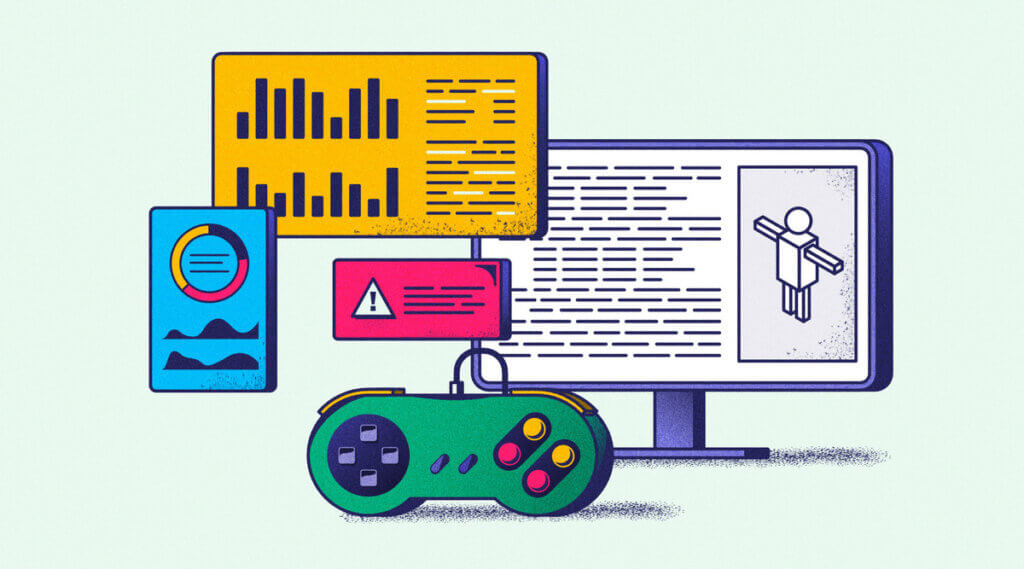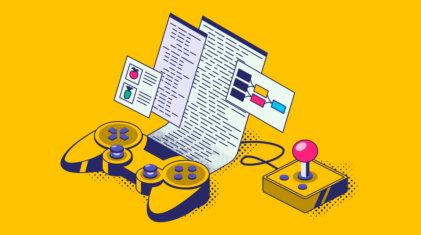Benefits of Learning Python for Game Development
The world of computer games is vast, ranging from single-player agility games and logic puzzles with simple 2D animations to the stunning graphics in 3D rendered…
Whether you are just starting your observability journey or already are an expert, our courses will help advance your knowledge and practical skills.
Expert insight, best practices and information on everything related to Observability issues, trends and solutions.
Explore our guides on a broad range of observability related topics.


The gaming industry is an extensive software market segment, reaching over $225 billion US in 2022. This staggering number represents gaming software sales to users with high expectations of game releases. User acquisition takes up a large part of software budgets, with $14.5 billion US spending globally in 2021. User retention is critical to the success of any game, especially where monetization requires driving in-app purchases and ad revenue. User engagement is also a key performance indicator of the success of your game which can be measured using a log monitoring tool. User retention and engagement require a great game concept and a great user experience.
Delivering a stellar user experience takes time, which is something gaming industries are always fighting against. User retention is highly dependent on releasing new features fast. When new features are released early, they can introduce bugs that can negatively impact user experience. In such a cut-throat, time-sensitive market, there is no time to thoroughly test the complex new features before release, which is standard in many other software sectors. Instead, gaming software depends on user feedback and tools to assist teams in fixing problems.
Observability tools are invaluable to game developers, customer experience specialists, and LiveOps teams. With machine-learning-enabled analytics and alerting, teams can identify and respond proactively. The speed of patch releases can be increased, and the number of released bugs can reduce. The benefit of observability is an excellent user experience, enabling increased user retention.
Observability is the ability to understand the inner workings of a software system quickly so you can ask questions about the system without any prior knowledge. The benefit of observability is that teams are made aware of potential issues earlier. Observability tools can help teams fix issues before the user experience suffers. It is more than simply a combination of logs, traces, and metrics in a single visualization. The proper observability tool can show defects in software before release without developers predicting any particular issue.
Observability tools make use of data from throughout the gaming software. Information about the stability and health of the software infrastructure, databases, network interactions, and the game software function should all be collected. They can be shown in full context, including the user’s device and operating system. With robust monitoring data collection, observability tools can predict and pinpoint problems effectively. When developers do not need to think up every enumeration for a possible failure, feature releases with enormous tool sprawl become more successful with the benefit of observability.
An overarching benefit of observability in gaming software is the minimization of downtime. Downtime in gaming is anytime the user is not actively engaged in some activity. This includes necessary times for loading content or allowing other players to take turns, but it also has unintentional problems like network outages, unoptimized software, and scheduled maintenance. Game designers tend to minimize this time since it increases user retention. It is evident when a game’s server or a console’s network is having problems, and many gamers flock to third-party sites to report the issues.
Observability tools offer faster reporting of issues than standard monitoring or user monitoring can offer. LiveOps teams can be alerted to issues quickly and respond proactively to problems requiring intervention.
Downtime is widespread immediately after new feature releases. These releases tend to include complex software and infrastructure compiled by different teams across a company. With such sprawl, it is difficult to predict every potential issue, and inevitably, some bugs are not explicitly tested for in integration testing. Observability benefits quick feature releases by predicting and catching issues early, even when not explicitly tested, by analyzing observability data.
The gaming industry must also support its software on many different hardware and software platforms. When all monitoring data is combined, it can be difficult to compile in a way that will catch issues specific to only a particular device. Teams must also be able to identify problems that occur in regional networks against issues in a particular server or cloud provider. Further, each user could have a different game version, complicating troubleshooting. When given complete contextual information, including location, software version, and device, observability tools can isolate issues that would otherwise be lost in the noise when the problem is isolated to a particular subset of users. These insights will allow your team to deliver a better gaming experience with fewer errors and downtime.
Insights from observability data can show user behaviors that otherwise would go unnoticed. These insights can provide feedback on game design to better-improve game development and inform new features.
Insights can come from subtle patterns in user data. For example, suppose a statistically significant number of users tend to leave the game at a particular point in the storyline or gaming experience. In that case, there may be a usability or software issue to be addressed. Other unusual behavior patterns can also be analyzed to improve the gaming experience. Keeping users engaged in the game will increase the number of in-game transactions they complete.
Observability tools must be well-integrated into your software and infrastructure to be effective. No matter which analytics tool is chosen, it will need access to three data types: logs, metrics, and distributed traces. Each of these should have sufficient contextual data to be combined for analysis in the observability tool.
While integrating a new observability tool into a large codebase seems like an enormous undertaking, it can be done iteratively. Results will still benefit the areas integrated with the tool, so best to start with a single platform that is suspected of having bugs. Continue integrating with other platforms until the entire codebase has instrumented observability.
Many options for observability tools exist which could integrate with gaming platforms. Considerations when choosing an observability tool should include:
The cost of observability tools can include many different factors. Many solutions require a licensing fee and charge for features in analyzing data to gain insights. With high-volume software like gaming, a large part of the cost will be data storage.
Time to instrument your software to record observability data. Extra time to implement the observability tool is also needed with open-source solutions. Third-party solutions take some extra burden off your in-house team by maintaining the observability tool.
Since the gaming industry is exceptionally fast-paced, consider the time required between game release and when you will have actionable insights displayed. The shorter this time, the faster you can use this data to improve your game.
The gaming industry requires robust observability solutions to find and fix issues efficiently before users are adversely affected. Observability tools can benefit the gaming industry by improving the process of finding issues throughout a game’s code, infrastructure, and network. The benefits of observability also reach game design decisions by finding areas where users display abnormal behavior.
Observability must be instrumented in all game platforms but can be integrated iteratively. Each of the three data types should be included for each platform to gain valuable insights. Choose an observability tool where data can be collected and analyzed to empower LiveOps to handle bugs effectively. Consider a tool that reduces the cost of ample data storage, reduces implementation time, and optimizes the speed to deliver valuable insights into your game.

The world of computer games is vast, ranging from single-player agility games and logic puzzles with simple 2D animations to the stunning graphics in 3D rendered…

AIOps is a DevOps strategy that brings the power of machine learning to bear on observability and system management. It’s not surprising that an increasing number…

Coralogix is not just another monitoring or observability platform. We’re using our unique Streama technology to analyze data without needing to index it so teams can…
